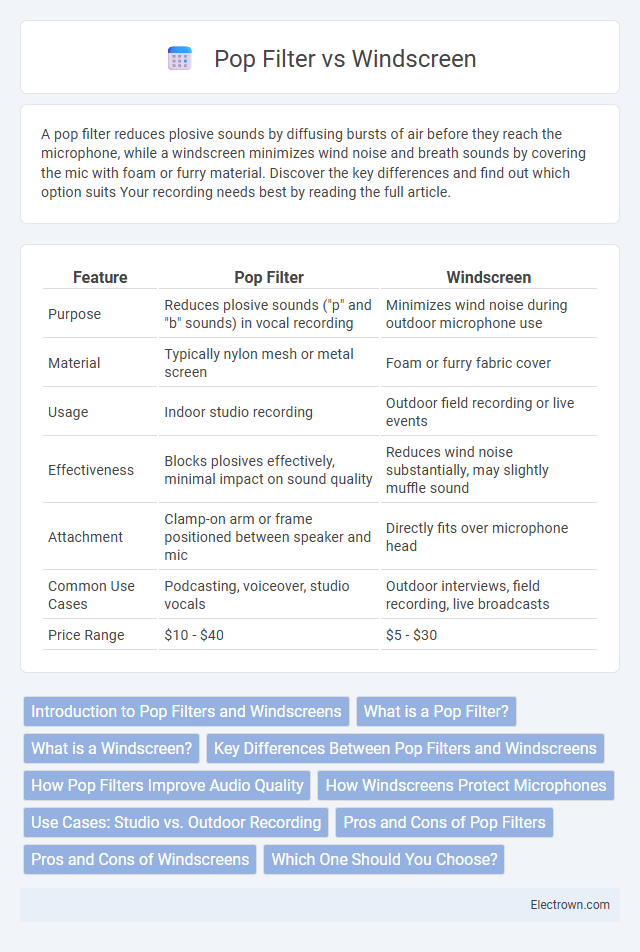A pop filter reduces plosive sounds by diffusing bursts of air before they reach the microphone, while a windscreen minimizes wind noise and breath sounds by covering the mic with foam or furry material. Discover the key differences and find out which option suits Your recording needs best by reading the full article.
Table of Comparison
| Feature | Pop Filter | Windscreen |
|---|---|---|
| Purpose | Reduces plosive sounds ("p" and "b" sounds) in vocal recording | Minimizes wind noise during outdoor microphone use |
| Material | Typically nylon mesh or metal screen | Foam or furry fabric cover |
| Usage | Indoor studio recording | Outdoor field recording or live events |
| Effectiveness | Blocks plosives effectively, minimal impact on sound quality | Reduces wind noise substantially, may slightly muffle sound |
| Attachment | Clamp-on arm or frame positioned between speaker and mic | Directly fits over microphone head |
| Common Use Cases | Podcasting, voiceover, studio vocals | Outdoor interviews, field recording, live broadcasts |
| Price Range | $10 - $40 | $5 - $30 |
Introduction to Pop Filters and Windscreens
Pop filters and windscreens serve distinct purposes in audio recording environments to enhance sound quality. Pop filters are designed to reduce plosive sounds caused by fast-moving air from consonants like "P" and "B," protecting sensitive microphones from distortion. Windscreens, typically made from foam, minimize wind noise and breath sounds during outdoor or high-wind recordings, ensuring clearer audio capture.
What is a Pop Filter?
A pop filter is an essential audio accessory designed to reduce plosive sounds caused by fast-moving air hitting the microphone during speech or singing. It consists of a thin mesh screen placed between the vocalist and the microphone, effectively minimizing harsh "p" and "b" sounds that can distort your recordings. Using a pop filter enhances vocal clarity and protects your microphone from moisture buildup, ensuring high-quality audio capture.
What is a Windscreen?
A windscreen is a foam or mesh accessory designed to cover a microphone, reducing wind noise and plosive sounds during outdoor recordings or live performances. It effectively minimizes unwanted air disturbances without affecting the audio quality, making it ideal for field recording and broadcasting. Windscreens are typically larger and thicker than pop filters, providing superior protection against environmental noise.
Key Differences Between Pop Filters and Windscreens
Pop filters and windscreens serve distinct purposes in audio recording: pop filters primarily reduce plosive sounds caused by fast-moving air hitting the microphone, while windscreens minimize wind noise and breath sounds during outdoor or high-wind conditions. Pop filters are typically made of nylon mesh and positioned between the vocalist and microphone, whereas windscreens are foam covers that encase the microphone itself. Understanding these key differences helps optimize sound quality based on the specific recording environment and vocal technique.
How Pop Filters Improve Audio Quality
Pop filters improve audio quality by reducing plosive sounds caused by sharp bursts of air hitting the microphone, which can create unwanted distortion. Unlike windscreens that primarily protect against wind noise in outdoor settings, pop filters are designed to maintain vocal clarity during close-up recording sessions. Using a pop filter enhances the crispness and professionalism of your recordings, ensuring clearer speech and vocal tracks.
How Windscreens Protect Microphones
Windscreens protect microphones by reducing wind noise and plosive sounds, preventing distortion during outdoor recordings or in environments with strong air movement. Made from foam or furry materials, windscreens absorb and diffuse air blasts before they reach the microphone diaphragm, preserving audio clarity. Unlike pop filters, which primarily target plosives in controlled settings, windscreens offer broader protection against environmental elements for sensitive microphone capsules.
Use Cases: Studio vs. Outdoor Recording
Pop filters excel in studio recording by reducing plosive sounds and protecting microphones from saliva, making them ideal for vocals and voiceovers. Windscreens are better suited for outdoor recording, effectively minimizing wind noise and environmental interference to maintain audio clarity. Choosing the right tool depends on Your recording environment to ensure optimal sound quality.
Pros and Cons of Pop Filters
Pop filters reduce plosive sounds by diffusing bursts of air during vocal recording, enhancing audio clarity and protecting microphones from saliva damage. They are lightweight and easy to position but can sometimes cause slight high-frequency attenuation, impacting the natural brightness of the voice. Unlike windscreens, pop filters are less effective in outdoor environments where wind noise is prevalent.
Pros and Cons of Windscreens
Windscreens provide effective protection against plosive sounds and wind noise, making them ideal for outdoor recordings or high-wind environments. They are typically made of foam, which offers durability and easy maintenance but may slightly reduce high-frequency clarity compared to pop filters. Your choice depends on balancing sound quality with environmental needs and practical handling during recording sessions.
Which One Should You Choose?
Choosing between a pop filter and a windscreen depends on your recording environment and microphone type. A pop filter effectively reduces plosive sounds during close vocal recording in controlled settings, while a windscreen offers better protection against wind noise and breath sounds in outdoor or rough environments. For studio vocals, a pop filter is ideal; for outdoor recording or dynamic mics, a windscreen is the preferred choice.
pop filter vs windscreen Infographic

 electrown.com
electrown.com